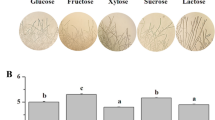Abstract
Growth and toxigenesis by Fusarium graminearum R6576, were compared in four liquid media. Parameters monitored during the fermentation were deoxynivalenol (DON) and 15-acetyl deoxynivalenol (15-ADON) production, fungal mass, carbohydrate utilization, and pH. Factors which were varied included basal medium composition, corn steep liquor (CSL) concentration, sucrose concentration and ammonium tartrate concentration. Growth in modified Fries medium resulted in only low levels of DON (0.25 mg/ L) and 15-ADON (0.25 mg/ L) after 20 days. Addition of 4% CSL to modified Fries medium raised the 20 day DON yield to 16.5 mg/ l. Increasing the sucrose concentration in modified Fries medium amended with 4% CSL resulted in increased mycelial dry weight but decreased levels of DON. Concentrations of ammonium tartrate greater than 1% in modified Fries amended with 4% CSL greatly reduced DON yield. Use of glucose-yeast extract-peptone (GYEP) for toxin production resulted in higher yields of 15-ADON (14.0 mg/ L) than DON (5.5 mg/ L) after 20 days. However, supplementation of GYEP with 4% CSL resulted primarily in DON production (4.5 mg/ L) after 20 days. In general, qualitative and quantitative production of DON and 15-ADON by Fusarium graminearum R6576 were dependent on the composition of the complex liquid medium.
Similar content being viewed by others
References
Cappellini, R. A. & J. L. Peterson, 1965. Macroconidium formation in submerged cultures by a nonsporulating strain of Gibberella zeae. Mycologia 57: 962–966.
El-Banna, A. A., P. Y. Lau & P. M. Scott, 1983. Fate of mycotoxins during processing of foodstuffs; II: Deoxynivalenol (vomitoxin) during making of Egyptian bread. J. Food Prot. 46: 484–486.
Greenhalgh, R., G. A. Neish & J. D. Miller, 1983. Deoxynivalenol, acetyl deoxynivalenol, and zearalenone formation by Canadian isolates of Fusarium graminearum on solid substrates. Appl. Environ. Microbiol. 46: 625–629.
Hanson, R. S. & J. D. Phillips, 1981. Chemical composition, p. 333. In P. Gerhardt (ed.), Manual of methods for general bacteriology, p. 333. American Society for Microbiology, Washington, D.C.
Hart, L. P., W. E. Braselton & T. C. Stebbins, 1982. Production of zearalenone and deoxynivalenol in commercial sweet corn. Plant Disease 66: 1133–1135.
Hart, L. P. & W. E. Braselton, 1983. Distribution of vomitoxin in dry milled fractions of wheat infected with Gibberella zeae. J. Agr. Food Chem. 31: 657–659.
Hart, L. P., J. J. Pestka & M-T. Liu, 1984. Effect of kernel development and moisture on production of deoxynivalenol in wheat infected with Gibberella zeae. Phytopathology 74: 1415–1418.
Jarvis, B., 1971. Factors affecting the production of mycotoxins. J. Appl. Bacteriol. 34: 199–213.
Kamimura, H., M. Nishijima, K. Saito, K. Yasuda, A. Ibe, T. Nagayama, H. Ushiyama & Y. Naoi, 1979. The decomposition of trichothecene mycotoxins during food processing. J. Food Hyg. (Japan) 20: 352–357.
Miller, J. D., A. Taylor & R. Greenhalgh, 1983. Production of deoxynivalenol and related compounds in liquid culture by Fusarium graminearum. Can. J. Microbiol. 29: 1171–1178.
Miller, J. P., J. C. Young & H. L. Trenholm, 1983. Fusarium toxins in field corn. I. Time course of fungal growth and production of deoxynivalenol and other mycotoxins. Can. J. Bot. 61: 3080–3087.
Moore-Landecker, E., 1972. Fundamentals of the fungi, p. 151. Prentice-Hall, Englewood Cliffs, NJ.
Morooka, N., N. Uratsuji, T. Yoshizawa & I. Yamamoto, 1972. Studies on the toxic substances in barley infected with Fusarium spp. J. Food Hyg. Soc. (Japan) 13: 368–375.
Nelson, P. E., T. A. Toussoun & W. F. O. Marasas, 1983. Fusarium species, an illustrated manual for identification. Penn. State Univ. Press, University Park.
Perlman, D., 1967. Microbial production of therapeutic compounds. In H. J. Pepper (Ed.), Microbial technology. Reinhold, New York.
Pringle, R. B. & R. P. Scheffer, 1963. Purification of the selective toxin of Periconia circinata. Phytopath. 53: 785–787.
Scott, P. M., 1983. The occurrence of vomitoxin in Canadian grains. Toxigenic fungi — their toxins and health hazard. Abstracts of the Third International Mycological Congress, Tokyo, Japan.
Trucksess, M. W., S. Nesheim & R. Eppley, 1984. Thin layer chromatographic determination of deoxynivalenol in wheat and corn. J. Assoc. Off. Anal. Chem. 61: 40–43.
Tuite, J., 1969. Plant pathological methods — fungi and bacteria, pp. 1–81. Burgess Press, Minneapolis, Minn.
Ueno, Y., 1980. Toxicological evaluation of trichothecene mycotoxins, pp. 663–671. In D. Eaker and T. Wadstrom (Eds.), Natural toxins. Pergamon Press, New York.
Ueno, Y., M. Sawano & K. Ishii, 1975. Production of trichothecene mycotoxins by Fusarium species in shake cultures. Appl. Microbiol. 30: 4–9.
Vesonder, R. F., A. Ciegler & A. H. Jensen, 1973. Isolation of the emetic principle from Fusarium-infected corn. Appl. Microbiol. 26: 1008–1010.
Vesonder, R. F., J. J. Ellis, W. F. Kwolek & D. J. DeMarini, 1982. Production of vomitoxin on corn by Fusarium graminearum NRRL 5883 and Fusarium roseum NRRL 6101. Appl. Environ. Microbiol. 43: 967–970.
Vesonder, R. F., A. Ciegler, R. F. Rogers, K. A. Burbridge, R. J. Bothast & A. H. Jensen, 1978. Survey of 1977 crop year preharvest corn for vomitoxin. Appl. Environ. Microbiol. 36: 885–888.
Yoshizawa, T. & N. Morooka, 1975. Biological modification of trichothecene mycotoxins: Acetylation and deacetylation of deoxynivalenol by Fusarium spp. Appl. Microbiol. 29: 54–58.
Yoshizawa, T. & N. Morooka, 1977. Trichothecenes from mold-infested cereals in Japan, pp. 309–320. In J. Rodricks, C. W. Hesseltine & M. A. Mehlman (Eds.), Mycotoxins in human and animal health, Pathotox Publishers, Park Forest South, IL.
Author information
Authors and Affiliations
Rights and permissions
About this article
Cite this article
Pestka, J.J., El-Bahrawy, A. & Patrick Hart, L. Deoxynivalenol and 15-monoacetyl deoxynivalenol production by Fusarium graminearum R6576 in liquid media. Mycopathologia 91, 23–28 (1985). https://doi.org/10.1007/BF00437282
Issue Date:
DOI: https://doi.org/10.1007/BF00437282




